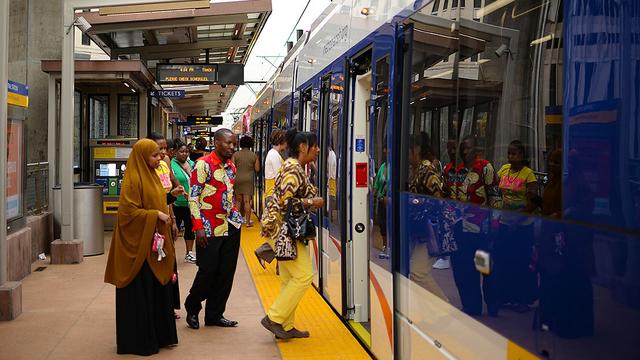When you see people riding a city bus, it seems logical to assume that every one of those passengers is being treated equally. But researchers at the Humphrey School of Public Affairs are exploring several aspects of our main transportation systems that show just how their designs put women at a disadvantage.
Those disparities are basic features of transportation infrastructure, the researchers say in a series of articles posted by the Gender Policy Report, published by the Humphrey School’s Center on Women, Gender, and Public Policy.
The Gender Policy Report puts academic research into short, accessible formats, and into the hands of policy makers and advocates, with the goal of promoting greater gender equality and equity in all policy domains. In this series of posts, the issues the researchers address primarily revolve around public transportation—such as buses and commuter trains—and bicycling.
PUBLIC TRANSPORTATION
Public transportation is only working for about 50 percent of the population, says researcher Ania McDonnell, a Master of Public Policy candidate at the Humphrey School.
Building on previous research by Humphrey School Professor Yingling Fan that explored women's safety and mobility needs, McDonnell looks at how transportation professionals can develop effective solutions in their own communities.
Safety Concerns
Women who ride on public transit report that they often feel unsafe while waiting at platforms for a bus or a train and are sometimes harassed, according to Fan’s research. They also feel unsafe walking home from the bus or train stop, especially if they are coming home at night after working a late shift. Women who work low-income or hourly jobs are disproportionately affected, and are less likely to have other transportation options available to them.
McDonnell says public transportation service providers should have meaningful discussions with their diverse passengers to gain a better understanding of their concerns about safety. And they must take steps toward implementing policies that will address those needs.
Carework
In addition to design issues around women’s safety, McDonnell says public transportation also fails to account for the ways that women typically move around. One example is "trip chaining,” where a rider makes multiple stops to take children to and from school or daycare, run errands, and go to appointments.
These caregiving tasks disproportionately fall to women, regardless of their socioeconomic class, and they occupy a significant portion of the day. As a result, women have less time to take care of themselves, less time to work at their paid jobs, and less time to spend with their families.
A related phenomenon, time poverty, often causes women to take part-time jobs closer to home to make up for the time lost with their families. This limits their employment opportunities and can further reduce their earning potential.
McDonnell says addressing these gender disparities will require federal, state, and local policies that address the different mobility needs of men and women.
Read McDonnell’s complete report.
CYCLING
The gender disparity in transportation extends to bicycling as well, says Greg Lindsey, Humphrey School professor of urban and regional planning. Women are far less likely to bicycle than men, he says, and one major reason is that women are concerned about their safety when they’re out biking.
Recent research by Lindsey’s students for Hennepin County shows their concern is warranted.
A field experiment they conducted yielded the unexpected result that vehicle drivers were significantly more likely to encroach—to pass closer than three feet—on a female cyclist than on male cyclists. Under Minnesota law, drivers are required to provide cyclists a berth of at least three feet.
To be sure, the vast majority of drivers kept a safe distance from the cyclists. But of the 33 encroachments that occurred, 73 percent were on the female rider. The rate of encroachment in the field test came out to 1 percent, which sounds very low, but the actual number of encroachments that occur is quite high, Lindsey says.
Residents of Minneapolis and St. Paul take between 31 and 36 million bicycle trips each year, according to the Minnesota Department of Transportation. This means that literally thousands of encroachments occur per year. And, even though there are fewer women cyclists, holding the number of passing events equal, they are more than three times likely to be encroached upon.
Lindsey says his study illustrates the scope and pervasiveness of the gender gap in cycling, and underscores the need for greater investment in safer facilities like protected bike lanes.
Read Lindsey’s complete blog post
About the Gender Policy Report
The Gender Policy Report is a nonpartisan, multidisciplinary effort to produce and disseminate timely, gender-focused analyses of emerging federal policy proposals and developments. Sign up to receive the biweekly digest.


